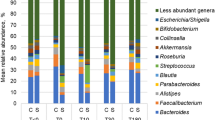Abstract
Studies of colonic microflora have indicated there are two distinct populations, one intraluminal and one mucosal surface-associated. This investigation further characterizes the mucosal surface microflora and assesses the effects of common preoperative bowel preparations on both microflora. Quantitative and qualitative bacterial cultures and scanning electron microscopy were used to study the microflora in five groups of seven rats each: control; intraoperative colonic instillation of ten percent povidone-iodine for 20 minutes; mechanical preparation with magnesium citrate; mechanical preparation followed by intramuscular cefoxitin (30 milligrams per kilogram) one hour preoperatively; and mechanical preparation followed by oral neomycin sulfate and erythromycin base (15 milligrams/kilogram each) given by gavage tube 18, 14, and 4 hours preoperatively. Microflora on the mucosal surface was visualized by scanning electron microscopy in all groups except the neomycin/erythromycin group. Results showed fewer bacterial isolates recovered from the mucosal surface compared with the lumen, as well as several log10 units lower for each bacterial classification. The greatest suppression of both microflora was seen in the neomycin/erythromycin group. Total aerobic and anaerobic luminal counts decreased by 3.7 (P < 0.009) and 6.3 (P < 0.009) log10 units, while total aerobic and anaerobic wall counts decreased by 2.3 (P < 0.009) and 2.8 (not significant) log10 units, respectively. Lesser reductions were noted in the povidone-iodine group (P < 0.009,P < 0.009,P < 0.009, and P < 0.048, respectively). There were no statistically significant reductions in either total aerobic or anaerobic counts in the mechanical preparation or cefoxitin groups. These results indicate that neomycin/erythromycin is the most effective regimen in reducing both microflora.
Similar content being viewed by others
References
Bollard JE, Vanderwee MA, Smith GW, Tasman-Jones C, Gavin JB, Lee SP. Location of bacteria in the mid-colon of the rat. Appl Environ Microbiol 1986;51:604–8.
Hartley CL, Neumann CS, Richmond MH. Adhesion of commensal bacteria to the large intestine wall in humans. Infect Immun 1979;23:128–32.
Phillips M, Lee A, Leach WD. The mucosa-associated microflora of the rat intestine: a study of normal distribution and magnesium sulphate induced diarrhoea. Aust J Exp Bio Med Sci 1978;56:649–62.
Rozee KR, Cooper D, Lam K, Costerton JW. Microbial flora of the mouse ileum, mucous layer and epithelial surface. Appl Environ Microbiol 1982;43:1451–63.
Tannock GW, Archibald RD, Brockett M, Crichton G. Scanning electron microscopy of microbial populations in the gastrointestinal tract of mice. Proc Univ Otago Med School 1984;62:58–9.
Lee A. Normal flora of animal intestinal surfaces. In: Bitton G, Marshall KC, eds. Adsorption of microorganisms to surfaces. New York: John Wiley and Sons Interscience Publishers, 1980:145–73.
Savage DC, Dubos R, Schaedler RW. The gastrointestinal epithelium and its autochthonous bacterial flora. J Exp Med 1968;127:67–76.
Savage DC. Associations and physiological interactions of indigenous microorganisms and gastrointestinal epithelia. Am J Clin Nutr 1972;25:1372–9.
Savage DC, Blumershine RV. Surface-surface associations in microbial communities populating epithelial habitats in the murine gastrointestinal ecosystem: scanning electron microscopy. Infect Immun 1974;10:240–50.
Cota-Robles EH, Ringo DL. The structure of the bacterial cell. In: Braude AI, ed. Infectious diseases and medical microbiology. 2nd ed. Philadelphia: WB Saunders, 1986:4.
Humphrey BA, Dickson MR, Marshall KC. Physicochemical and in situ observations on the adhesion of gliding bacteria to surfaces. Arch Microbiol 1979;120:231–8.
Lewin RA. A classification of flexibacteria. J Gen Microbiol 1969;58:189–206.
Condon RE, Bartlett JG, Greenlee H, et al. Efficacy of oral and systemic antibiotic prophylaxis in colorectal operations. Arch Surg 1983;118:496–502.
Rotstein OD, Wells CL, Pruett TL, Simmons RL. Reevaluation of the “instant” colon preparation with povidone-iodine. Surg Forum 1985;35:70–1.
Schrogie JJ, Davies RO, Yeh KC, et al. Bioavailability and pharmacokinetics of defoxitin sodium. J Antimicrob Chemother 1978;4(suppl B):69–78.
Arango A, Lester JL, Martinez OV, Malinin TI, Zeppa R. Bacteriologic and systemic effects of intraoperative segmental bowel preparation with povidone iodine. Arch Surg 1979;114:154–7.
Jones FE, DeCosse JJ, Condon RE. Evaluation of “instant” preparation of the colon with povidone-iodine. Ann Surg 1976;184:74–9.
Weinstein WM, Onderdonk AB, Bartlett JG, Gorbach SL. Experimental intra-abdominal abscesses in rats: development of an experimental model. Infect Immun 1974;10:1250–5.
Braude AI. Mechanisms of natural resistance to infection. In: Braude AI, ed. Infectious diseases and medical microbiology. 2nd ed. Philadelphia: WB Saunders, 1986:655–7.
Andrassy RJ. Preserving the gut mucosal barrier and enhancing immune response. Contemp Surg 1988;32(2-A):1–40.
Keighley MR. Prevention of wound sepsis in gastrointestinal surgery. Br J Surg 1977;64:315–21.
Nichols RL, Broido P, Condon RE, Gorbach SL, Nyhus LM. Effect of preoperative neomycin-erythromycin intestinal preparation on the incidence of infectious complications following colon surgery. Ann Surg 1973;178:453–62.
Nichols RL, Condon RE, Gorbach SL, Nyhus LM. Efficacy of preoperative antimicrobial preparation of the bowel. Ann Surg 1972;176:227–32.
Abrams GD. Microbial effects on mucosal structure and function. Am J Clin Nutr 1977;30:1880–6.
Davis CP, McAllister JS, Savage DC. Microbial colonization of the intestinal epithelium in suckling mice. Infect Immun 1973;7:666–72.
Davis CP, Mulcahy D, Takeuchi A, Savage DC. Location and description of spiral-shaped microorganisms in the normal rat cecum. Infect Immun 1972;6:184–92.
Nelson DP, Mata LJ. Bacterial flora associated with the human gastrointestinal mucosa. Gastroenterology 1970;58:56–61.
Plaut AG, Gorbach SL, Nahas L, Weinstein L, Spanknebel G, Levitan R. Studies of intestinal microflora. Gastroenterology 1967;53:868–73.
Savage DC, McAllister JS, Davis CP. Anaerobic bacteria on the mucosal epithelium of the murine large bowel. Infect Immun 1971;4:492–502.
Nichols RL, Gorbach SL, Condon RE. Alteration of intestinal microflora following preoperative mechanical preparation of the colon. Dis Colon Rectum 1971;14:123–7.
Kager L, Malmborg AS, Nord CE, Pieper R. The effect of short-term cefoxitin prophylaxis on the colonic microflora in patients undergoing colorectal surgery. Infection 1982;10:338–40.
Author information
Authors and Affiliations
Additional information
Read in part at the American College of Surgeons-Surgical Forum, Small Intestine and Colon Session, Chicago, Illinois, October 25, 1988.
This study was supported in part by a grant from Merck, Sharp, and Dohme, West Point, Pennsylvania.
About this article
Cite this article
Lindsey, J.T., Smith, J.W., McClugage, S.G. et al. Effects of commonly used bowel preparations on the large bowel mucosal-associated and luminal microflora in the rat model. Dis Colon Rectum 33, 554–560 (1990). https://doi.org/10.1007/BF02052206
Issue Date:
DOI: https://doi.org/10.1007/BF02052206




